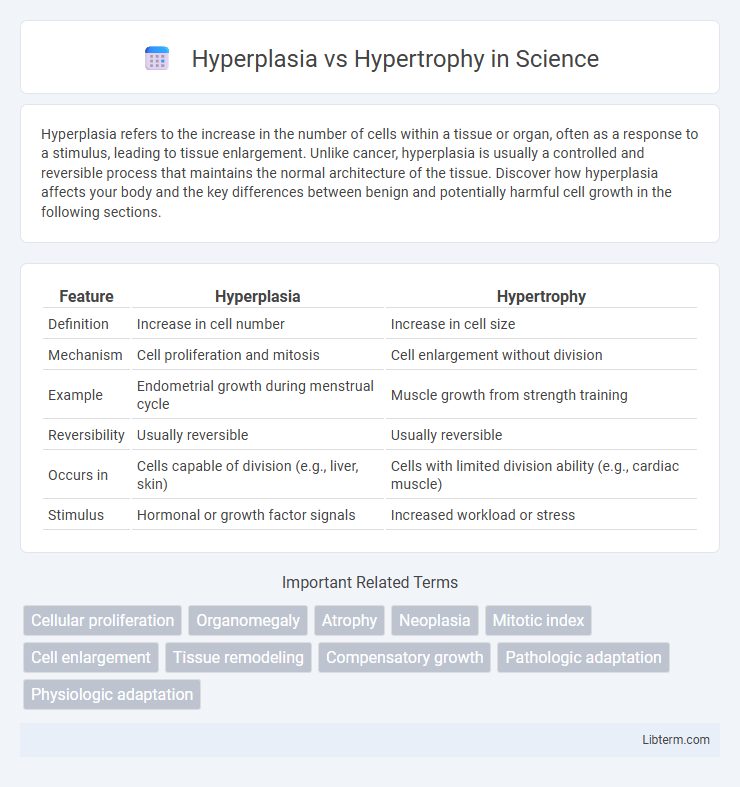Hyperplasia refers to the increase in the number of cells within a tissue or organ, often as a response to a stimulus, leading to tissue enlargement. Unlike cancer, hyperplasia is usually a controlled and reversible process that maintains the normal architecture of the tissue. Discover how hyperplasia affects your body and the key differences between benign and potentially harmful cell growth in the following sections.
Table of Comparison
| Feature | Hyperplasia | Hypertrophy |
|---|---|---|
| Definition | Increase in cell number | Increase in cell size |
| Mechanism | Cell proliferation and mitosis | Cell enlargement without division |
| Example | Endometrial growth during menstrual cycle | Muscle growth from strength training |
| Reversibility | Usually reversible | Usually reversible |
| Occurs in | Cells capable of division (e.g., liver, skin) | Cells with limited division ability (e.g., cardiac muscle) |
| Stimulus | Hormonal or growth factor signals | Increased workload or stress |
Understanding Hyperplasia and Hypertrophy
Hyperplasia involves an increase in the number of cells within a tissue or organ, leading to its enlargement, often stimulated by hormonal signals or increased functional demand. Hypertrophy refers to the enlargement of existing cells, resulting in increased tissue or organ size without a change in cell number, commonly seen in muscle growth or cardiac tissue adaptation. Both processes contribute to tissue growth but differ in cellular mechanisms and physiological contexts.
Key Differences Between Hyperplasia and Hypertrophy
Hyperplasia involves an increase in the number of cells, leading to tissue enlargement, whereas hypertrophy is characterized by an increase in the size of existing cells without cell division. Hyperplasia commonly occurs in tissues with high regenerative capacity, such as the liver and skin, while hypertrophy is typical in muscle tissues like cardiac and skeletal muscles. Key molecular signals driving hyperplasia include growth factors that stimulate cell proliferation, while hypertrophy is primarily regulated by mechanical stress and protein synthesis pathways.
Biological Mechanisms Behind Hyperplasia
Hyperplasia involves an increase in cell number through mitotic division, driven by growth factors such as epidermal growth factor (EGF) and transforming growth factor-beta (TGF-b), activating intracellular signaling pathways like MAPK and PI3K/AKT. This process contrasts with hypertrophy, which is characterized by an increase in cell size without cell division, relying heavily on protein synthesis and cellular organelle expansion. Hyperplasia occurs primarily in tissues with high mitotic potential, such as epithelial and glandular tissues, enabling regeneration and repair through controlled cell proliferation.
Cellular Mechanisms of Hypertrophy
Cellular mechanisms of hypertrophy involve an increase in cell size primarily due to enhanced protein synthesis and organelle expansion, driven by mechanical stress and growth factor signaling pathways such as IGF-1/Akt/mTOR. Unlike hyperplasia, which entails an increase in cell number through mitosis, hypertrophy relies on the enlargement of existing cells to meet higher functional demands. This process is critical in muscle tissue adaptation, cardiac remodeling, and other physiological responses to increased workload.
Causes and Triggers of Hyperplasia
Hyperplasia occurs as a result of increased cellular proliferation triggered by hormonal stimulation, chronic irritation, or tissue injury signaling mechanisms. Common causes include hormonal changes such as elevated estrogen levels inducing endometrial hyperplasia, growth factors promoting wound healing, and persistent inflammation leading to cellular adaptation and expansion. Understanding the molecular pathways involving growth factors like epidermal growth factor (EGF) and cytokines provides insight into the mechanisms that differentiate hyperplasia from hypertrophy, which involves cell size increase without cell number change.
Factors Leading to Hypertrophy
Hypertrophy occurs primarily due to increased mechanical load or resistance training, which stimulates muscle fiber enlargement by promoting protein synthesis and satellite cell activation. Hormonal factors such as elevated testosterone, growth hormone, and insulin-like growth factor 1 (IGF-1) play a critical role in enhancing hypertrophic responses by facilitating muscle repair and growth. Nutritional intake, especially adequate protein consumption, supports hypertrophy by providing essential amino acids required for muscle tissue regeneration and hypertrophic adaptation.
Physiological Examples in the Human Body
Hyperplasia in the human body is exemplified by the increase in the number of cells in the uterine lining during the menstrual cycle, promoting tissue regeneration. Hypertrophy occurs in skeletal muscles during strength training, where individual muscle fibers enlarge to enhance muscle mass and strength. Both processes are essential for adapting to physiological demands without the pathological complications associated with uncontrolled cell growth.
Pathological Conditions Involving Hyperplasia
Pathological conditions involving hyperplasia include benign prostatic hyperplasia, which causes enlarged prostate glands leading to urinary difficulties, and endometrial hyperplasia, often linked to abnormal uterine bleeding and increased risk of endometrial cancer. Hyperplasia is characterized by an increase in cell number due to stimuli such as hormonal imbalances, chronic irritation, or growth factors, differentiating it from hypertrophy, which involves cell size enlargement without cell proliferation. Understanding these mechanisms is crucial for diagnosing and managing diseases where cellular proliferation contributes to tissue enlargement and dysfunction.
Diseases Associated with Hypertrophy
Hypertrophy is commonly associated with diseases such as hypertrophic cardiomyopathy, where cardiac muscle cells enlarge abnormally, leading to thickened heart walls and impaired function. In conditions like hypertension, the heart undergoes pathological hypertrophy as a compensatory response to increased workload, often resulting in heart failure if untreated. Unlike hyperplasia, hypertrophy involves the increase in cell size rather than cell number, making it a critical factor in organ dysfunction in various cardiovascular diseases.
Clinical Implications and Treatment Approaches
Hyperplasia involves an increase in cell number, often seen in benign prostatic hyperplasia (BPH), requiring treatments such as alpha-blockers or 5-alpha-reductase inhibitors to reduce gland size and alleviate urinary symptoms. Hypertrophy, characterized by enlarged cell size as in cardiac hypertrophy, demands management through antihypertensive medications, lifestyle changes, and monitoring to prevent heart failure. Understanding the distinct cellular mechanisms aids clinicians in selecting targeted therapies that address the underlying pathology and improve patient outcomes.
Hyperplasia Infographic

 libterm.com
libterm.com